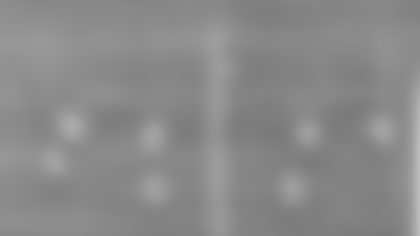Imagine it's the end of September in Jacksonville. The season's only a month underway, but the hometown Jaguars have won three out of four games, including a two-score win over the Patriots, and another deep playoff run looks to be in line. The Blake Bortles extension might still seem questionable, but he's yet again doing enough to guide the team to a division title.
Fast forward 10 weeks and Cody Kessler is the starting quarterback, there's a new offensive coordinator and the Jaguars have lost eight of their last nine games. The goal has shifted from playoff wins to draft order and figuring out their quarterback position.
This week we'll focus on how the Jaguars offense operates with Kessler at the helm, and how their defensive line is still a force despite decreased sack totals.
Kessler has completed passes at a high rate since becoming the starter in Jacksonville. In two of the three games he's played in this season he's finished with at least a 70 percent completion rate. Using Pro Football Focus' adjusted completion rate, which accounts for dropped passes, throwaways, batted passes and spiked balls, Kessler is fifth in the league with a 78.9 percent completion rate.
That all sounds good, but there are reasons for that high completion rate, and they're not good reasons.
While the whole team has figuratively dropped the ball this season, the Jaguars receivers have carried that idiom with them to the field. Jacksonville leads the league in dropped passes with 28 this season. The difference between them and the next-worst team is equal to the distance between second place and 15th. Accounting for those drops boosts Kessler's adjusted completion rate.
Kessler has had 7.2 percent of his passes dropped this season, the third-highest rate in the league behind Josh McCown (7.3 percent) and Bortles (7.9 percent), so the Jaguars have really cornered that market.
Another boost to Kessler's completion rate comes from his tendency to throw short, safe passes. Kessler consistently throws the ball well short of the sticks, relying on his receivers to find extra yards after the catch.
Next Gen Stats tracks the average depth of target for quarterbacks to give an accurate picture of which quarterbacks are gunslingers and which are checkdown captains. Kessler would be the latter of the two based on his play this season. He has thrown the ball 2.1 air yards shorter than the first down marker on average. That is the fourth-shortest average among quarterbacks with at least 95 pass attempts. Eli Manning, C.J. Beathard and Jeff Driskel are the three players who throw it shorter on average.
But as Kessler has found out, checking the ball down in Jacksonville is not always a safe play.
Imagine it's the end of September in Jacksonville. The season's only a month underway, but the hometown Jaguars have won three out of four games, including a two-score win over the Patriots, and another deep playoff run looks to be in line. The Blake Bortles extension might still seem questionable, but he's yet again doing enough to guide the team to a division title.
Fast forward 10 weeks and Cody Kessler is the starting quarterback, there's a new offensive coordinator and the Jaguars have lost eight of their last nine games. The goal has shifted from playoff wins to draft order and figuring out their quarterback position.
This week we'll focus on how the Jaguars offense operates with Kessler at the helm, and how their defensive line is still a force despite decreased sack totals.I
Kessler has completed passes at a high rate since becoming the starter in Jacksonville. In two of the three games he's played in this season he's finished with at least a 70 percent completion rate. Using Pro Football Focus' adjusted completion rate, which accounts for dropped passes, throwaways, batted passes and spiked balls, Kessler is fifth in the league with a 78.9 percent completion rate.m
That all sounds good, but there are reasons for that high completion rate, and they're not good reasons.a
While the whole team has figuratively dropped the ball this season, the Jaguars receivers have carried that idiom with them to the field. Jacksonville leads the league in dropped passes with 28 this season. The difference between them and the next-worst team is equal to the distance between second place and 15th. Accounting for those drops boosts Kessler's adjusted completion rate.g
Kessler has had 7.2 percent of his passes dropped this season, the third-highest rate in the league behind Josh McCown (7.3 percent) and Bortles (7.9 percent), so the Jaguars have really cornered that market.i
Another boost to Kessler's completion rate comes from his tendency to throw short, safe passes. Kessler consistently throws the ball well short of the sticks, relying on his receivers to find extra yards after the catch.n
Next Gen Stats tracks the average depth of target for quarterbacks to give an accurate picture of which quarterbacks are gunslingers and which are checkdown captains. Kessler would be the latter of the two based on his play this season. He has thrown the ball 2.1 air yards shorter than the first down marker on average. That is the fourth-shortest average among quarterbacks with at least 95 pass attempts. Eli Manning, C.J. Beathard and Jeff Driskel are the three players who throw it shorter on average.e
But as Kessler has found out, checking the ball down in Jacksonville is not always a safe play.

Against the Texans, on a third-and-six situation, Kessler threw a pass short of the first down marker to his running back T.J. Yeldon, hoping the back would break a tackle for the first down. Instead it bounced off Yeldon's hands and was snagged by safety Tyrann Mathieu.
The pass wasn't perfectly on-target, to be fair, and Kessler led Yeldon more than was necessary, but the end result was Yeldon getting two hands on the ball and popping it up into the air for the turnover.
But the Jaguars were never supposed to rely on their passing attack to win games. Last season they fought their way to the AFC Championship game by playing top-tier defense and running the ball often. They finished first in the league in rush yards per game and were ninth in yards per rush, helping them get to fifth in scoring offense.
This season their offense has fallen to the bottom of the league. They're 20th in rush yards per game, 27th in rushing yards per carry and 30th in points. Pro Football Focus has the Jaguars as the lowest graded rushing attack in the league. While running the ball is less efficient than passing the ball, the Jaguars were at least good rushing last season. The same can't be said this season.
When they have had rushing success this season it's mostly come out of shotgun. The Jaguars average over a yard more per carry when running out of shotgun than when the quarterback is under center. Stopping the Jaguars rushing attack will be a focus for a Redskins defense that has crumbled against the run in the second half of the season.
After starting out the season allowing an average of 80.1 rushing yards per game through Week 8, the Redskins have allowed 149.8 per game over their last six games. They'll need to take advantage of a Jaguars team that has stubbornly stuck to an inefficient rushing attack. Jacksonville currently ranks 12th in the league in rushing attempts per game at 26.3, which is still a drop off from last year's league-leading 33.1.
The catch is their fall from ninth in yards per carry last year to the aforementioned 27th, which hasn't led to a change in offensive ideology. They average nearly the same total passing yards per game, but the rest of the league has outpaced them. They're near the bottom of the league in passing yards per game (24th), and that number looks even worse when Cody Kessler starts.
Expect to see a lot of carries for No. 27 on Sunday, and the success of those carries should serve as a barometer for the Redskins' chances of a victory in Duval County.
On defense, the story of the Jaguars' season has been the case of the missing sacks. Last season the Jaguars defensive line was ending opponent drives with huge sacks nearly every game. They earned the Sacksonville moniker by putting opposing quarterbacks on the ground 55 times, or 3.4 per game. Through 13 games this season the Jaguars only have 25 sacks, or 1.9 per game.
But it's not like their defensive line has been slacking. The Jaguars are fifth in the league with a 32.5 percent pressure rate according to Football Outsiders. Last season they were third in the league, and only registered pressures on 1.8 percent more plays.
Sacks are a volatile stat, and shouldn't be counted on year-to-year. The Jaguars have probably just caught the other side of variance this season. In this article from 2017, ESPN staff writer Bill Barnwell wrote a section specifically about the volatility of sacks. He considers knockdowns to be a better measure of a pass rusher's effect on the game, which points toward the Jaguars defensive line remaining a dangerous unit despite low sack totals.
The three mainstays on the Jaguars defensive line are Calais Campbell, Yannick Ngakoue and Malik Jackson. Last year the trio combined for 34.5 sacks but this year they've only notched 15 total. They have converted similar pressure totals into much fewer sacks, probably by no fault of their own.

Above is an example of Campbell doing everything that could be expected of him right up until the sack. He beats the left tackle Nate Solder immediately off the snap, fakes outside and then swims past Solder's inside. After that he has a straight path to Eli Manning, but just can't wrap him up and Manning steps up in the pocket, avoiding the sack. The pressure Campbell applied on the play ensured it wouldn't be successful, but with 11 seconds left in the first half and only one timeout, a sack would have ensured the Giants went straight to the field goal unit. Instead they had another shot at the end zone (that would fall incomplete).
Looking at Pro Football Focus' sack numbers and pressure totals for Campbell, Jackson and Ngakoue, it's clear that these players are still getting after the quarterback. What has changed is the rate of pressures to sacks. Last season Campbell turned 23.2 percent of pressures into sacks, a very high rate. This year that number has dropped to 16.7 percent. Jackson's rate has declined even more drastically, dropping from 17.6 percent to 2.5 percent of pressures resulting in sacks.
Washington has given up 35 sacks this season, but 16 of those have come in the last four games. With their interior offensive line looking just as precarious as last week (they started backup tackles at each guard spot), the matchup in the trenches leans heavily in Jacksonville's favor. Limiting the Jaguars to pressures instead of sacks would go a long way in helping the Redskins pull out a win this Sunday, and extend their playoff hopes.






